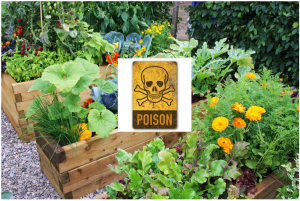“You will be interested to learn what charming vegetation grows on the surface of the globe.” — Tiger Tanaka to James Bond in Ian Fleming’s “You Only Live Twice.”
In Ian Fleming’s You Only Live Twice, the evil Dr. Shatterhand is causing headaches to the Japanese government with his “garden of death” — a castle and grounds filled with all manner of poisonous vegetation which the doctor has planted. His garden has become a mecca for those citizens looking to commit suicide, and Japan’s secret service recruits James Bond to “enter this castle of death and slay the dragon within.”
Such is the stuff of adventure novels, but bears little resemblance to real life. I say “little,” because most of us lack the time, money, and the insanity to plant a garden filled with strictly noxious plants for nefarious purposes. However, many of the common ordinary plants that we don’t think of as deadly may contain, in part or all of the plant, toxins that, if consumed, may cause illness or in some cases even death. Here are a few examples.
Asparagus – Eating the raw shoots when they’re young and green, can cause dermatitis. The berries that grow on the feathery leaves of the mature plant are also toxic. Eating more than a handful can cause nausea and vomiting.
Castor Bean — From the seed we get ricin, a highly toxic substance. Eight beans is enough to kill an adult human.
Foxglove — Ingestion of the leaves can cause irregular heartbeat and pulse — enough to kill.
Hyacinth, Narcissus, and Daffodil — Eating the bulbs can cause nausea, vomiting, and diarrhea — and even death.
Kidney beans – Kidney beans contain the toxin phytohaemagglutinin. A few raw beans will make the consumer violently ill; more than a handful can kill. To inactivate the toxin, beans must be boiled for at least ten minutes before being used raw in salads, cooked with other foods in a slow cooker.
Lima beans – Lima beans should never be eaten raw, as the raw beans contain the toxin limarin. A mere handful of raw lima beans can make someone violently ill.
Potato – The leaves, stems, and tubers that have turned green contain solanine. Solanine can cause gastric distress, headache, delirium, shock, paralysis, and occasionally death.
Rhubarb — The leaves contain oxalic acid. Eating the leaves can cause convulsions, coma, or death.
Tomato — Leaves contain tomatine, an alkaloid that can cause gastrointestinal upset. Tomato leaves can be used to make a homemade insecticide.
While most adults are smart enough not to consume stems and leaves from these aforementioned plants, a small child or pet may not know better. And one mistake could be the last. So let’s be safe in the garden and keep pets and children away from these and other potentially deadly plants.
